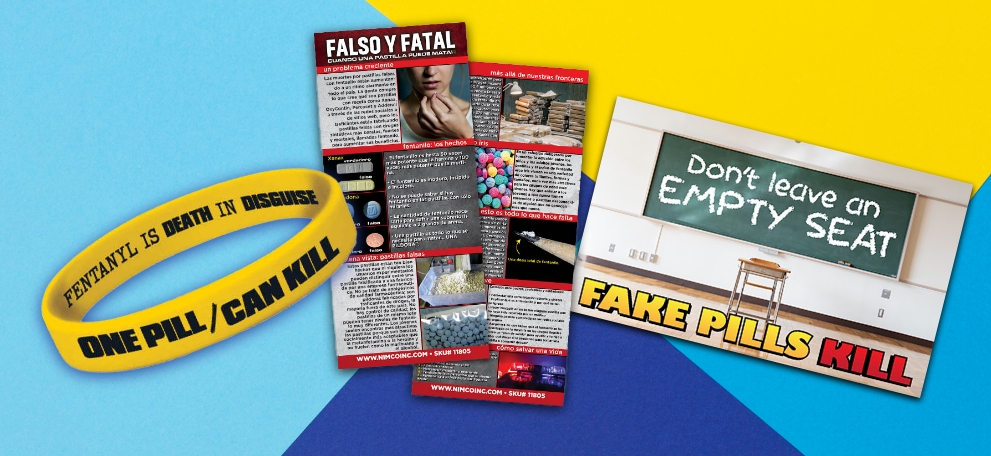In a world increasingly shadowed by the opioid crisis, the call for fentanyl awareness has never been more urgent. Fentanyl, a particularly menacing specter among synthetic opioids, is potent and perilous, weaving its way into communities large and small and leaving a trail of grief and loss. This reality is one that educators, school administrators and leaders of youth organizations cannot afford to ignore. Our goal is to arm you with knowledge and strategies to combat this crisis, specifically focusing on how to talk to teens about the dangers of fentanyl.

Understanding Fentanyl and Its Dangers
Fentanyl, a synthetic opioid, is increasingly becoming a concern across the United States due to its extreme potency, which is estimated to be about 50 to 100 times stronger than morphine. This drug was originally developed to treat intense pain from ailments like cancer, but it’s found its way onto the streets, where it’s often mixed with other substances, unknowingly to the user. This hidden danger significantly elevates the risk of overdose, making fentanyl awareness and understanding the dangers of fentanyl critical in today’s society. It’s more than a drug problem; it’s a community health crisis that requires attention and action from everyone, especially those in positions to educate and influence young minds
Fentanyl Awareness Day
Fentanyl Awareness Day is a critical initiative aimed at combating the growing fentanyl crisis. It focuses on increasing public knowledge about the dangers of fentanyl, sharing stories of those affected and encouraging widespread participation in prevention efforts. As we acknowledge this important day, let’s explore how everyone can get involved and make a meaningful impact.
Here’s how anti-bullying posters and banners can make a difference:
- Educate Yourself and Others: Take time to learn about fentanyl, its effects and the reasons why this type of substance abuse poses such a significant risk. Share this knowledge with friends and family and through social media to spread awareness.
- Participate in Community Events: Look for local gatherings, seminars and workshops on fentanyl awareness. These events often provide valuable information and ways to support those affected.
- Share Personal Stories: If you or someone you know has been impacted by fentanyl, sharing your story can be powerful. Personal stories resonate and can significantly influence others to take the dangers of fentanyl seriously.
- Advocate for Change: Contact local representatives to discuss the importance of policies and programs focusing on fentanyl education and prevention. Showing support for these initiatives can lead to positive changes in your community.
- Support Non-Profit Organizations: Many organizations work tirelessly to combat the fentanyl epidemic. Consider donating or volunteering to help amplify their efforts in education, fentanyl prevention and support services.

Tips on Communicating With Teens About Fentanyl
Discussing the dangers of fentanyl with teenagers can be challenging. But given the devastating effects of fentanyl, safety and prevention must be our priorities. Here are strategies and tips to help educators, parents and community leaders effectively engage in these important conversations:
- Start with Facts: Begin by sharing factual information about fentanyl, including its potency and the risk of overdose. This sets a solid foundation for understanding the seriousness of the issue.
- Create a Safe Space: Ensure the conversation takes place in a setting where teens feel safe and comfortable to express their thoughts and concerns.
- Listen Actively: Encourage teens to share their perspectives and listen without judgment. This approach fosters open communication and trust.
- Discuss the Real-Life Consequences: Share stories and statistics about how fentanyl has impacted individuals and communities to illustrate the real-world implications.
- Empower With Knowledge: Equip teens with the knowledge to make good decisions and recognize the signs of drug misuse in their surroundings.
- Encourage Questions: Let them know it’s okay to ask questions and be ready to answer them honestly or seek out the answers together.
- Highlight Support Systems: Inform teens about the resources and support systems available, whether it’s a trusted adult, school counselor or a helpline.
Fentanyl Awareness in Schools
The role of education in combating the fentanyl crisis cannot be overstated. Fentanyl in schools presents a unique challenge and opportunity for educators to make a significant impact. Implementing fentanyl awareness programs within the curriculum arms students with the knowledge they need to make informed decisions and recognize the dangers of fentanyl. Here’s how schools can integrate fentanyl education:
- Incorporate Fentanyl Education Into Health Classes: By discussing fentanyl and its effects as part of physical and mental health education programs, students can learn about the risks in a structured environment.
- Host Awareness Events: Schools can organize events with guest speakers, such as medical professionals or survivors of drug addiction, to share their experiences and knowledge about the dangers of opioid misuse.
- Create Safe Spaces for Discussion: Encourage open dialogues in classrooms or through student-led clubs, where students can express their thoughts and concerns about drug use and its impact.
- Utilize Peer Education Programs: Peer-led initiatives can be particularly effective in reaching teenagers. Training selected students to lead discussions and share information about fentanyl can foster a supportive community of informed individuals.
- Provide Resources for Further Learning: Make resources available for students who want to learn more about drug prevention, including websites, hotlines and local organizations that offer support and information.
- Display Awareness Signs and Banners: Posting fentanyl awareness signs or banners in classrooms, lunchrooms and other common areas can serve as constant reminders of the dangers of fentanyl and encourage students to stay informed.

Frequently Asked Questions: Fentanyl Awareness
Below, we’ve addressed some of the common questions created to promote fentanyl awareness. Please reach out if you’d like additional information.
What Is Fentanyl?
Fentanyl is a synthetic opioid that’s significantly more potent than heroin. Its presence in the illegal drug market contributes to the U.S. opioid crisis.
Why Is Fentanyl So Dangerous?
Its extreme potency and the risk of being combined with other drugs – without the user knowing – make fentanyl especially dangerous, leading to a higher likelihood of an accidental overdose.
How Can I Recognize Signs of Fentanyl Overdose?
Symptoms include severe respiratory distress, dizziness, confusion and unconsciousness. Immediate medical attention is critical.
When Is Fentanyl Awareness Day Observed?
National Fentanyl Awareness Day is observed on May 7th each year, uniting various stakeholders in raising awareness about the dangers of fentanyl.
Join Forces With NIMCO to Support Fentanyl Awareness
NIMCO, Inc. stands at the forefront of fentanyl awareness efforts, providing educators, school administrators and community leaders with effective tools to educate and engage teens about the dangers of fentanyl. From informative fentanyl awareness posters to impactful fentanyl awareness shirts to vital information about Naloxone, NIMCO offers several products designed to foster meaningful discussions and promote safety. Explore NIMCO’s educational resources and join the movement to spread awareness and save lives. Together, we can make a difference.
Real Deal on Fentanyl | Youth Fentanyl Awareness
The United States is witnessing an unprecedented surge in drug overdose fatalities, primarily driven by the synthetic opioid fentanyl.
Related Articles: Fentanyl Awareness



